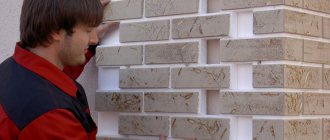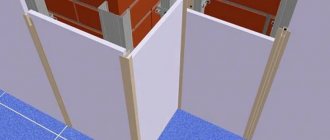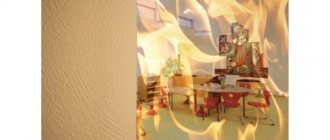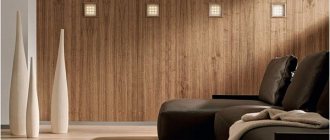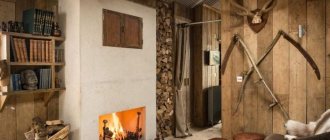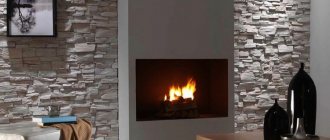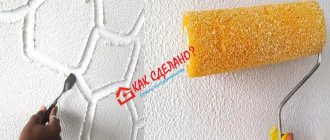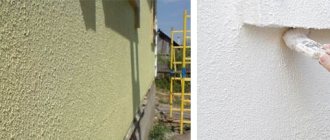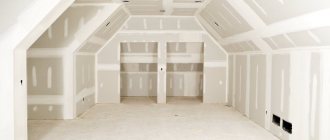The use of leather wall decoration indoors began in ancient Rome, creating luxurious rooms for important people. At the beginning of the 21st century, leather as a finishing material in the interior began to gain popularity again. Thanks to its natural origin and modern manufacturing technologies, this material is absolutely harmless, environmentally friendly and can be used in any living space, including children's rooms. With the advent of the Art Nouveau (modern) and art deco styles, luxurious wall decoration began to occupy a leading position among designers, then gradually leather finishing materials began to be used in other style solutions. Since approximately 2011, the luxury of finishing luxury hotel rooms and offices has migrated to apartment design. In this regard, manufacturers of finishing materials began to produce new decorative elements that can be conveniently used for interior work.
Leather finishing materials
Leather wall coverings are available in various versions. Among the most popular:
- Panels. Ordinary wall panels of standard sizes, only the outer covering is leather. The advantages of leather panels: softness, flexibility, ductility, ease of use, the ability to replace one element in case of damage to the skin.
- Wallpaper. Luxurious finishing material, usually 10 meters per roll, available in different colors and patterns. Advantages of leather wallpaper: looks great on the wall, soft, warm, creates a unique atmosphere of comfort and luxury.
- Tile. Rectangular or square tiles, like panels, have leather as an outer covering. Available in either a single color or with a pattern in the form of panels or individual elements. Advantages: creating panels, decorating individual sections of the wall, ease of work.
When choosing options for finishing materials made of leather, they are guided by the recommendations of finishers and designers. Leather is an expensive material (although its durability fully justifies the cost) and requires special attention, so it would be best to entrust the finishing of the room to professionals. The slightest excess will turn the room from a luxurious room into a shocking one, or, even worse, into kitsch.
Question No. 2. What are the available materials “under the skin”?
We are so used to gluing wallpaper in the room and tiles in the bathroom that we are amazed when we begin to wonder what other materials exist on the market. In addition to artificial leather, which can be used for upholstery of walls or ceilings, there are many options that are also more convenient to use: ready-made “leather” panels, panels, slabs, textured plasters and decorative coatings.
A “leather” texture can be obtained using the same wallpaper, but with a “leather-like” coating. Haven’t you heard about genuine leather floor tiles? A great material for a bedroom floor, by the way.
All these types of finishes have their advantages and disadvantages, but if we take the criteria of durability-aesthetics-price-versatility as a basis, then decorative plasters certainly come out on top.
Advantages of leather as a finishing material
Leather is a “breathable” material, therefore it creates additional microcirculation of air, it is warm, and has a specific smell, thanks to which the room is filled with a barely noticeable subtle pleasant aroma. Coatings made from this natural material absorb noise well and do not absorb odors.
A unique feature is the change in appearance of wall coverings over time. Under the influence of air temperature, changing humidity and other processes occurring in the room, the skin changes, becomes softer, loses its newly installed appearance, creating additional comfort and an atmosphere of sophistication.
To summarize, the following advantages can be highlighted:
- strength and durability guaranteed by manufacturers;
- environmental cleanliness and safety, which can be preserved in finished products thanks to modern technologies;
- inflammability, enhanced by special means covering the surface of the materials;
- noise reduction;
- heat saving;
- sophistication, increasing every year.
In addition, decorating walls with leather is luxury, prestige and comfort. Thanks to modern production and new technologies, the luxury of finishing a room with leather is now affordable for many consumers. The cost of the material and work depends on the area of the walls; you can use leather trim as a decorative element, which is quite affordable for people with average and lower incomes.
Question No. 3. How does decorative plaster imitate leather?
Decorative plasters “under the skin” are essentially masses that hold their shape well. Using special tools, stencils and application methods, you can give the plaster a texture, and additional dyes, varnishes and glazes will bring the surface to a realistic look. And here it’s up to you to choose whether you want “cow skin”, “crocodile skin” or “python”.
Among the textured plasters, from which you can create a “skin-like” effect, you can find acrylic or vinyl based materials with the addition of marble, sand and other natural components.
But the most unimaginable modern material is Loggia Plasma 3D (pictured). The fact is that with it you can create absolutely any texture, including a very massive one, with deep cracks, for example, and at the same time the resulting surface is so durable that this plaster can be applied not only to the wall, but also to the floor, or, for example , on the countertop or cabinet fronts. This material is easy to work with, you don’t even need to prepare the wall - imagine, it can be applied directly on top of laminate, ceramic tiles or self-adhesive wallpaper.
Well, after creating a specific texture “like the skin” with the help of finishing coatings (varnishes, glazes), you can give the surface a very realistic “wild” color or, conversely, a fantasy one.
Which rooms are suitable for wall decoration with leather?
Previously, leather was used to decorate cabinets in expensive restaurants, luxurious rooms in hotels, cabinets in saunas and similar establishments. But for several years now, designers have been using this material in decorating residential premises. At first these were personal offices, dining rooms and living rooms; now it is considered stylish to decorate the walls of the bedroom, guest rooms, fireplace room and billiard room with leather.
Soft Leather Wall Panels
This is not only a guarantee of beauty and comfort of the room. Wall panels carry such positive functions as additional sound insulation of walls and thermal insulation. The soft base of such panels is most often foam rubber with a thickness of about three to five centimeters, which in itself is a good sound absorber. In addition to foam rubber, you can lay a layer of isolon - this way the wall panel will improve its sound insulation properties. Soft wall panels will decorate any interior. The design of the panels can be absolutely anything: from simple smooth surfaces to a combination of various upholstery materials and subsequent quilting with decorative buttons. Exquisite carriage tie, Swarovski crystals, original genuine leather of exotic animals (ostrich, crocodile, iguana, python) - you can order all this and much more by contacting us.
Leather wall finishing options
There are several options for finishing walls with leather. It is possible to completely or partially decorate the surface, combine it with other materials, or place a mosaic or panel. In case of intersection with other materials, the naturalness of their origin should be taken into account.
Wood is most often used in combined finishing. For those who can afford it, mahogany or other noble species are preferable. This season, Japanese interior style has come into fashion, using plant-based finishing materials combined with leather elements.
In the bedroom, as a rule, the head of the bed is decorated, highlighting it as a separate design element. Leather is used to cover either a section of the wall or the entire wall of the headboard. Mosaic bindings made of materials of two colors have come into fashion.
In the living room, this can be a panel, a niche, or entire walls, decorated with several colors in contrast or to match.
In the kitchen, mosaic or panels are preferable, in the office the same, but in more strict colors. The office uses panels, wallpaper, tiles, at the choice and discretion of its owner.
It is recommended to use panels or tiles in the hallway, wallpaper in the fireplace room, and the same in the billiard room.
Finishing methods
Before finishing with faux leather panels, the walls must be prepared. To do this, they are leveled, which can be done using plywood or drywall. If the walls are smooth, they must be cleaned of dirt and dust, plastered and coated with primer. After this, markings are made along which the first row of panels will be laid. PVA glue is used for installation. Its application is carried out on both surfaces - on the wall and decorative items.
Leather panels are installed according to the same principle as ceramic tiles. There should be no trimmings on the most visible part of the wall. Work must begin starting from the surface opposite the entrance. When finishing walls with panels, their laying can be carried out not only in a symmetrical order. In the video you can watch the installation process of products that are located on the wall in an asymmetrical order. You can combine products with different colors, taking into account their combination with other finishes.
When covering walls with leather wallpaper, you need to take into account that the canvas may have an adhesive backing. In this case, no special composition is required for installation. Water should not come into contact with the adhesive base. If there is no corresponding layer, you need to use one-component adhesive. The surface must be dry and free of wax, silicone and dust. The walls are degreased and coated with primer 5 hours before work begins. When gluing the canvases, use a wallpaper spatula to eliminate air bubbles. The fabric should not be stretched. There should be no dents or voids on the walls, otherwise all this will appear on the cladding.
Options for finishing walls with leather in the interior
Technology for fastening soft leather wall cladding
Leather panels are installed on the wall using almost the same principle as ceramic tiles. Such products are good because they are able to mask the unevenness of the walls, so their preparation will only consist of removing poorly retained elements of the old finish and applying a primer, which will increase the adhesive properties of the materials.
If wallpaper is applied to the wall, it should be removed by covering the surface with two layers of primer. Between approaches, the material is left to dry. Using a pencil, mark on the surface the area where the eco-leather panels are supposed to be glued. It is better to start working in one of the corners. Each product must be checked using a level horizontally and vertically. In order to stick panels or leather tiles for wall decoration, glue is applied to its reverse side. You can use its hot analogue. Using a gun, it is most convenient to distribute the composition over the surface, and then press the products against the wall.
An alternative solution is liquid nails. The joining of adjacent elements should be as tight as possible so that seams do not form. If there are framing elements, they need to be fixed at the last stage. Usually this decor is included in the package.
Decor features
When decorating residential premises with leather, you should follow several rules so that the final result does not look bad taste. First of all, balance is necessary, since everything is good in moderation.
You cannot create a feeling of satiety. The amount of textiles, wood and other materials should prevail over the amount of leather coverings. For example, it would be inappropriate to decorate all the walls with leather plus leather furniture, ceilings and floors. Leather, as a luxury material, in itself is the highlight of the interior. Therefore, it is not recommended to include it in all parts of the room’s interior.
When choosing leather finishing materials, you should pay attention to their quality. It is necessary to carefully inspect not only the external, but also the internal surface of the tiles or panels. It is necessary to take into account the factor of durability, the fact that the interior design of the room will remain unchanged for many years, and not choose bright, eye-catching colors.
Leather processing process
Once the material has acclimatized, which will take approximately 24 hours, you can begin to work with it. If the walls have already been prepared, glue should be applied to both sides of the surfaces to be glued. Next, the panels or tiles are applied to the base and pressed well, while trying to level the product in place. The main difficulties arise when there is a need to install extreme products. In order to adjust them to size, trimming should be done. The panels and tiles consist of two layers, so before cutting they are separated from each other, the base is trimmed, and then the skin, connecting the elements together using glue or a stapler. After this, the panel can be replaced.
What you need to know
This kind of wall decoration can hardly be called a novelty. It was already popular several years ago. Now there has been an almost triumphant return - the material began to play in a new reading and processing.
The designers appreciated the original look of such a decorative element. They widely use it in decorating the bedroom, much less often in decorating the living room. But beauty is not the only advantage.
Advantages
- Excellent suppression of noise and sounds. The relaxation room has what you need.
- They are easy to work with. You can even do the installation yourself.
- Able to hide wall imperfections. For example, unevenness and roughness, even large ones.
Instagram @izooom.ru
Instagram @dariaelnikova
Instagram @elenasavinova_design
Instagram @molotkova_design
Features of care
When choosing a material, it is important to take into account the features of its operation. The easiest way to care for products made from eco- and natural leather. They can be wiped with a damp cloth and dust does not accumulate on them. And those made of suede, nubuck or any fabric, on the contrary, attract dust and require appropriate care. At least once a month they are vacuumed and cleaned with special products.
- Walls
8 best materials for wall decoration in the loft style (for the most discerning taste)
Fillers
Another aspect that affects the price of finishing is the filler. Manufacturers offer two options.
- The first is foam rubber, it is more often used for the manufacture of thick slabs.
- The second is padding polyester. It is lighter and thinner, so products with such filling look more elegant. But it is also more expensive.
By the way, the cost of custom-made slabs is another good reason to think about installing them. But, if you are not afraid of these characteristics, we suggest taking a closer look at the use of elements using the example of design projects.
Structure of soft panels for walls
Due to their three-dimensional shape, such panels are called 3D panels. They have a multilayer structure and in cross section look like this:
- the first layer is made of PVC backing with a width of 5-8 cm, which has high adhesive properties to various adhesive bases and increased strength;
- the second layer is presented in the form of a filler made of foam rubber, padding polyester or mineral wool, and serves to retain heat and sound;
- the third layer is made of upholstery material and is responsible for the decorative characteristics of the panels.
Thanks to this composition, soft wall panels are wear-resistant, beautiful and have important properties - sound insulation and thermal insulation.
Soft wall panels with crocodile skin effect
Soft wall panels for upholstery
Installation and Installation
Installation is so simple that it does not require special knowledge or even experience in construction work. You can deal with it yourself. There are several ways to attach soft wall panels to a wall.
On glue
To do this, you must first prepare the wall - plaster, putty and prime. This will improve the adhesion of the slabs and the surface.
PVA or liquid nails are suitable as glue. Installation can be carried out as you wish: from top to bottom, from bottom to top, and from the side. The main thing is to make markings.
- Apply PVA to the surface of the element (if using liquid nails, a few dots are enough).
- Press the trim down. Be careful not to leave glue too close to the edge. By pressing, you will squeeze out the glue and may damage the element.
In stores you can also find decorative products with a self-adhesive base, which are even easier to work with.
Instagram @makers.design
Instagram @oneandhome.ru
Instagram @polinov
On magnets
Some manufacturers offer their own mounting system - using magnets. Each element is equipped with several magnets on the back side. They are attached to metal strips mounted on the wall. Interestingly, such a magnetic system does not affect the operation of electrical appliances in any way, but it can withstand the weight of decorative trim.
Instagram @interiors_dd
Design: Tatiana Alenina Bureau
Instagram @irina_grave
